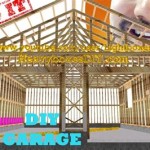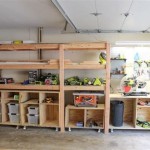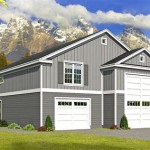Can You Put A Dryer Vent In The Garage? Understanding the Risks and Regulations
The question of whether a dryer vent can be routed into a garage is a common one, particularly when homeowners face spatial constraints or seek simplified installation options. However, the answer is not a straightforward yes or no. Venting a dryer into an enclosed space like a garage presents several potential hazards and violates building codes in many jurisdictions. This article will explore the reasons behind these restrictions, the potential dangers involved, and offer alternative, safer venting solutions.
Dryer vents are designed to expel hot, moist air and lint away from the dryer unit. This airflow is crucial for several reasons. First, it facilitates the drying process by removing the moisture evaporated from the clothes. Second, it prevents overheating within the dryer, which can damage the appliance and create a fire hazard. Finally, it carries away lint – small fibers detached from clothing during the drying cycle. This lint is highly flammable and, if allowed to accumulate, poses a significant fire risk.
Venting a dryer into a garage introduces several problems. Unlike the open air, a garage is a relatively confined space. This means that the hot, moist air and lint discharged by the dryer will accumulate within the garage. The increase in humidity can lead to mold and mildew growth, potentially damaging stored items and affecting air quality within the garage and, subsequently, the attached home. The accumulation of lint creates a serious fire hazard, and the potential for carbon monoxide buildup from a gas dryer is a life-threatening concern.
The Dangers of Dryer Venting into a Garage
The dangers associated with venting a dryer into a garage are multifaceted and substantial. Understanding these potential risks is essential for making informed decisions about dryer venting strategies.
One of the most significant concerns is the
increased risk of fire
. Dryer lint is extremely flammable. When a dryer is vented outdoors, the lint is carried away by the airflow and dispersed. However, when vented into a garage, the lint settles onto surfaces, creating layers of highly combustible material. A spark from a tool, a hot engine, or even static electricity can ignite this accumulated lint, leading to a rapid and devastating fire. Garages often contain flammable materials like gasoline, paint, and cleaning supplies, which would exacerbate the situation.Another major hazard is
moisture buildup and mold growth
. The hot, moist air expelled by a dryer contains significant amounts of water. In an open environment, this moisture dissipates quickly. However, within the enclosed space of a garage, the humidity levels rise substantially. This elevated humidity creates an ideal environment for mold and mildew to thrive. Mold and mildew can damage building materials, such as drywall and wood framing, leading to costly repairs. Furthermore, mold spores can be harmful to human health, causing allergic reactions, respiratory problems, and other health issues. These health risks extend beyond the garage itself, as mold spores can easily travel into the attached home.Finally,
carbon monoxide poisoning
is a critical concern if the dryer is gas-powered. Gas dryers, unlike electric dryers, produce carbon monoxide as a byproduct of combustion. Proper venting is essential to safely exhaust this poisonous gas to the outside. Venting a gas dryer into a garage allows carbon monoxide to accumulate to dangerous levels. Carbon monoxide is odorless and colorless, making it difficult to detect. Exposure to carbon monoxide can cause flu-like symptoms, confusion, loss of consciousness, and even death. Even small amounts of carbon monoxide exposure over prolonged periods can have detrimental health effects. The risk is heightened in attached garages, as carbon monoxide can easily seep into the living areas of the home.Building Codes and Regulations Regarding Dryer Venting
Most building codes strictly prohibit venting a dryer into an enclosed space like a garage. These regulations are in place to protect homeowners from the inherent dangers associated with such a practice. Building codes are designed to ensure the safety and well-being of residents and are enforced by local authorities. Violating these codes can result in fines, legal action, and the requirement to correct the improper venting at the homeowner's expense.
International Residential Code (IRC), a widely adopted standard for residential construction, generally prohibits venting clothes dryers into enclosed spaces. The IRC requires that dryer exhaust systems terminate outdoors and be equipped with a backdraft damper. The specific requirements may vary depending on local amendments and interpretations of the code, but the underlying principle remains consistent: dryer exhaust must be safely expelled to the exterior of the building.
Homeowners should consult with their local building department or a qualified HVAC professional to determine the specific requirements in their area. These professionals can provide guidance on proper dryer venting practices and ensure compliance with applicable codes. Ignoring building codes can have serious consequences, including safety hazards and legal repercussions.
Furthermore, it is important to note that even if local codes are unclear or seemingly lenient, the inherent dangers of venting a dryer into a garage remain. Prioritizing safety should always take precedence over convenience or perceived cost savings.
Alternative and Safer Dryer Venting Solutions
Fortunately, there are several alternative dryer venting solutions that provide safe and effective exhaust without compromising safety or violating building codes. These options ensure proper moisture and lint removal, minimizing the risk of fire, mold, and carbon monoxide poisoning.
Traditional Outdoor Venting:
The most common and recommended solution is to vent the dryer directly to the outside using rigid metal ductwork. This involves installing a vent pipe that extends from the dryer to an exterior wall or roof, terminating in a vent hood with a backdraft damper. Rigid metal ductwork is preferred over flexible ductwork, as it is less prone to lint buildup and kinking, which can restrict airflow. The vent hood should be positioned in a location that allows for unobstructed airflow and is not susceptible to snow or debris accumulation. The length of the ductwork should be minimized to ensure efficient venting. Following the dryer manufacturer's recommendations regarding maximum duct length is crucial for optimal performance.Dryer Venting Boxes:
In situations where wall space is limited, a dryer venting box can be used. This type of box is recessed into the wall and provides a space for the dryer vent to connect. It directs the exhaust downward and out through the wall, allowing the dryer to be placed closer to the wall. Dryer venting boxes must be properly installed and sealed to prevent air leakage and moisture damage.Ventless Dryers:
As an alternative to traditional vented dryers, ventless dryers offer a solution that eliminates the need for external venting altogether. These dryers use condensation or heat pump technology to remove moisture from the clothes and collect it in a reservoir. The water reservoir must be emptied periodically. Ventless dryers are generally more energy-efficient than vented dryers, but they may require longer drying times and have a higher initial cost. While ventless dryers do not require external venting, it's still important to ensure adequate ventilation in the room where they are located to prevent moisture buildup.Lint Traps and Cleaning:
Regardless of the chosen venting method, regular maintenance is essential for safe and efficient dryer operation. Cleaning the lint trap after each load is crucial to prevent lint accumulation. Additionally, the dryer vent ductwork should be inspected and cleaned periodically to remove any built-up lint. A professional dryer vent cleaning service can ensure thorough removal of lint and debris, reducing the risk of fire and improving dryer performance. The frequency of cleaning depends on the dryer usage and duct length, but generally, an annual cleaning is recommended.By understanding the risks associated with improper dryer venting and exploring alternative solutions, homeowners can ensure the safety and efficiency of their laundry appliances. Consulting with qualified professionals and adhering to building codes are crucial steps in maintaining a safe and healthy home environment.

Can You Vent A Dryer Into The Garage

Running A Dryer Vent Through The Garage Doityourself Com

Dryer Vented Into Garage Inspecting Hvac Systems Internachi Forum

Learn How To Reroute Dryer Vent From Garage Outside

Venting A Clothes Dryer Into Garage Doityourself Com Community Forums

How To Install A Dryer Vent The Home Depot

Is It Safe To Install A Tumble Dryer In Garage Or Shed

Is It Safe To Install A Tumble Dryer In Garage Or Shed

How To Install A Dryer Vent The Home Depot

Why Does Venting A Clothes Dryer Into Garage Attic Or Crawl Space Cause Problems
Related Posts








